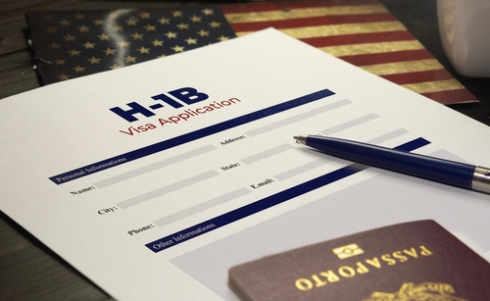For many of those highly skilled workers looking to build careers in the United States, the H-1B visa is an essential gateway. It’s the chance to get closer to professional advancement, a fresh start, and, for some, the possibility of long-term settlement. But how does the H-1B visa work, and how do you get one? Keep reading!
What is the H-1B Visa Used for?

The H-1B visa is one kind of work visa. It permits U.S. employers to recruit foreign workers for specialized jobs for a set period of time. These jobs typically require special skills or a four-year (or longer) college degree.The visa is designed to attract talented individuals to work in sectors such as technology, engineering, healthcare and finance, to name a few. H-1B visa is valid for three years, extendable for another three years; providing workers time to develop experience and secure a Green Card.
RELATED READ: 5 Jobs In Japan With Visa Sponsorship
Who is Eligible for the H-1B Visa?

Education:
- The minimum qualifications applicants must have are-
- An accredited bachelor’s degree (or higher).
- A foreign degree that is equivalent to a U.S. bachelor’s degree.
- Similar Work Experience (evaluated through credentialing agencies).
Specialized Skillset:
The position should call for specific skills relevant to your field of study. For instance, an IT developer must be able to code or design the software.
Evidence of Intent to Stay Temporarily:
The H-1B is a temporary visa, so you’ll have to show intent to work in the U.S. temporarily, despite dual intent allowing you to later apply for a green card.
Requirements for Employers:
Before filing an H-1B petition, the employer must get a Labor Condition Application (LCA) and submit the LCA to the Department of Labor (DOL) to establish:
- They will pay at least as much as the prevailing wage for the role.
- The employment will not negatively impact the working conditions of the U.S. workers.
A Step by Step guide to getting the H-1B Visa

Follow each step to ensure you are doing things right to get your H1-B visa:
Step 1: Employer Determines Eligibility
Your employer must take the specialty of your into account when assessing your eligibility. You need to have a bachelor’s (or higher) in a specific field for the job, and your employer must demonstrate this. They also need to find out the pay level of position and this varies according to industry and region.
Step 2: File the Labor Condition Application (LCA)
DOL certifies employer’s request to hire foreign worker by means of Form ETA-9035, whereby the employer maintains that employment of such foreign worker will not adversely impacting U.S. workers’ wages or working conditions.
Employers must also post notices at their worksites for 10 days to notify any U.S. employees that they intend to hire an H-1B worker.
Time frame for processing: LCA approval usually takes 7-10 business days.
Step 3: Enter the H-1B Lottery (if necessary)
Regular Cap: 65,000 H-1B visas are available each fiscal year.
Masters Cap: Another 20,000 visas are set aside for those with advanced degrees from U.S. universities.
Lottery system: Should applications exceed the cap, USCIS will engage a lottery system to pick them.
Step 4: Send in your Form I-129 (Petition for a Nonimmigrant Worker)
After certification of the employer’s LCA, the next step is submitting Form I-129 to USCIS, together with:
-
-
- Approved LCA.
- Proof of your qualifications (for example, diplomas, work experience)
- Job offer and evidence placing the position within the category of specialty occupation
- Filing fees. The employer must pay various fees, such as the base filing fee, the ACWIA fee, the fraud prevention fee, and the optional premium processing fee.
-
Step 5- The USCIS Processes the Petition
Time Frame: This may take several months; however, you can pay an additional $2500 (for premium processing), which guarantees a response within 15 days. Note that this does not ensure approval. It just speeds up the decision. All requirements must be met for approval.
Request for Evidence (RFE): If USCIS requires more information, it can issue an RFE. Candidates should submit promptly all requested documents.
Step 6: Consular Processing or Change of Status
Consular Processing: If you are outside the United States, you will also need to schedule a visa interview in person at a U.S. embassy or consulate.
Change of Status: If the applicant is already in the U.S. on another kind of visa, USCIS may permit a change of status to H-1B without the need for the applicant to exit the U.S.
RELATED READ: How to Switch to a Global Talent Visa in the UK: A Comprehensive Guide
Regular H-1B Visa Cap vs. Master’s Quota

The cap is basically the number of H-1B visas that the U.S. gives to applicants each year. Applicants and employers should know and plan around the cap system.
What is the H-1B Cap?
-
-
-
- Regular Cap: For those with a bachelor’s degree or its equivalent—65,000 visas.
-
-
-
-
-
- Master’s Cap (Advanced Degree Exemption): Another 20,000 visas are set aside for people with a master’s degree or higher from a U.S. institution.
-
-
How the Lottery System Works
If the petitions exceed the annual cap, USCIS performs a two-stage lottery:
-
-
-
- Regular cap selection: All applications are entered into the regular cap lottery.
-
-
-
-
-
- Master’s Cap Opt-In: Master’s degree applicants who were not selected from the first round will automatically be placed in a second lottery for the additional 20,000 visas.
-
-
Selection rates change from year to year, but in recent years, fewer than 30% of applicants have been selected due to high demand.
Who is Exempt from the Cap?
Certain H-1B petitions are not subject to the annual cap, including:
-
-
-
- Applications for roles in nonprofit research organisations, institutions of higher education, or government research institutions.
-
-
-
-
-
- Extensions of status for those who already hold H-1B status.
-
-
-
-
-
- H-1B transfer to new employer.
-
-
Important Dates to Remember
-
-
-
- Time for registration: The H-1B filing season kicks off every March (petitions usually open in April for the October 1st fiscal year).
-
-
-
-
-
- Lottery Results: Applicants chosen in a lottery will get notified within several weeks.
-
-
-
-
-
- Filing window: Eligible employers will have to file a full petition with USCIS during the filing window.
-
-
RELATED READ: Netherlands Work Visa Requirements 2025
How to Switch from a H-1B Visa to a Green Card?
To switch from a H-1B Visa to a Green card is very much possible but you would need to plan it carefully and understand all the legal routes.
Employment-Based Green Cards
The employment based green card has several types. They are-
-
-
- EB-2 (Advanced Degree Professionals): Which includes those with advanced degrees or those who have exceptional skills.
- EB-3 (Skilled Workers or Professionals): For persons with a bachelor’s degree or who have special skills.
-
These applications are usually sponsored by Employers undergoing the PERM (Program Electronic Review Management) process.
Family-Based Green Cards
H-1B holders married to U.S. citizens or Green Card holders can apply for family-sponsored Green Cards.
National Interest Waiver (NIW)
This is for persons with extraordinary ability or achievement. In this situation, you can apply for an EB-2 Green Card without an employer’s support if your work supports the US at a national level.
Steps to Transition
PERM Labor Certification
This certification is simply to show that employer has checked out the U.S. labor market to determine there is no one qualified for that position.
I-140 Immigrant Petition
-
-
- Identify the required Form I-140 rating procedure with the USA Citizenship and Immigration Services (USCIS). This is so that they can sponsor the applicant for a Green Card once the PERM has been approved.
- Then you must file Form I-485. This is the application for permanent residence or change of status.
- Those who are already in the U.S. must apply to adjust their status to become a green card holder by filing Form I-485. And if they are abroad, they must complete consular processing.
-
RELATED READ: Average Cost For A Work Visa For Europe
Difficulties in the Transition Process
Lengthy Processing Times:
There are quotas for Employment-based Green Cards, which results in backlogs, particularly for applicants from countries like India and China
Dependence on Employer:
The employer’s involvement is essential for the sponsorship to proceed.
H-1B Expiry During Process:
If there is a delay in the PR application, there would be a need to extend the visa.
RELATED POST: Everything You Must Know About Finland Work Visa
How long does it take to process a Green Card after the H-1B visa?

If you are a holder of an H-1B visa and are have completed the time period of your visa and need to remain in the U.S, then you need to know the rules for these extensions and renewals.
H-1B Visa Initial Validity Period
With the H-1B there is an initial grant of up to 3 years. It can be renewed for a further 3 years. Therefore the maximum validity period is 6 years.
Eligibility
-
-
- Green Card Application Pending: H-1B holders with pending employment-based Green Card petitions may qualify for one year or three year extension beyond 6 year limit.
- Recapturing Time Abroad: Time spent outside the U.S. during the H-1B validity period can be “recaptured” to extend the visa.
-
Steps for H-1B Visa Extension
Employer Files Form I-129 by submitting a new petition to USCIS, with evidence of continued work and satisfactory adherence with labor conditions.
Supporting Documents
-
-
- Certified LCA from the DOL.
- Proof of the still-specialized quality of the position.
-
Extensions require the current H-1B to be submitted before its expiration date to maintain lawful presence in the United States. In cases where an extension is filed timely, the H-1B worker is permitted to continue working up to 240 days while the petition is pending.
If the extension is denied, the H-1B holder must immediately leave the United States or change non-immigrant status if eligible.
H-1B cannot be extended indefinitely but AC21 might allow you to extend it beyond 6 years should your Green Card petition be filed and pending.
RELATED READ: How to Switch to a Global Talent Visa in the UK: A Comprehensive Guide
H-4 Visa: What H-1B Visa Holders Need to Know About Dependents
The H-1B visa allows skilled workers to live and work in the United States, and family members can join them on H-4 visas. The H-4 rules for dependents, spouse and unmarried children under 21 of H-1B penholders, are also similar.
Eligibility for the H-4 Visa
Spouse and unmarried children (under 21) of H-1B visa holders can hold the H-4 visa.
Based on the primary H-1B visa holder’s I-94 there is no automatic extension of stay for dependents, dependents must apply for and maintain their H-4 status independently.
What are the advantages and disadvantages of H-4 visa holders?

Living in the U.S.
H-4 visa holders can stay in the United States for the same period of time as the H-1B visa holder.
Education
H-4 Visa holders may attend any School, College, or University without any restriction.
Work Authorization
As a H-4 visa holders, you may be able to apply for an Employment Authorization Document (EAD) under certain circumstances if the H-1B visa holder has:
-
-
- What is Form I-140, Immigrant Petition for a Green Card
-
- AC21 extension of H-1B status beyond six years.
- This enables H-4 visa holders to work freely and without employer sponsorship.
-
Travel
As long as valid, H-4 visa holders can enter and exit United States.
How to Apply for an H-4 Visa
Visa Application
Dependents need to fill out Form DS-160 and attend a visa interview in their home country at a U.S. consulate or embassy.
Documentation
Required documents include:
-
-
- Relationship (marriage or birth) certificate
- Valid H-1B visa holder documentation (I-797 approval letter, employment letter).
-
Change of Status
If a dependent already has a visa to enter the U.S., they can apply for H-4 status. They just need to submit Form I-539 to USCIS.
RELATED READ: 5 Jobs In Japan With Visa Sponsorship
Avoiding Common Reasons for an H-1B Visa Denial

The H-1B visa process takes a long time and can be complicated, and many people get denied. The denial rates for H-1B visas can be high. Understanding the main reasons for these denials and how to avoid them can help improve your chances of getting your petition approved. The most common reasons for H-1B denials are-
#1. Lack of Evidence for Specialty Occupation
The H-1B visa is for workers in specialty occupations that require at least a bachelor’s degree (or its equivalent) in a specialized field. If not, it may be placed for denial.
How to Avoid:
-
-
- Confirm that the job description is well defined in terms of education required and that the applicant meets those criteria.
- Give precise evidence, including work experience and education background, proving the applicant is an expert in that particular field.
-
#2. Incomplete or incorrect Application Forms
One common reason for denial is submitting incomplete forms or not meeting deadlines to submit forms. The accuracy and completeness of forms is strictly enforced by USCIS.
How to Avoid:
Check all forms and documents before filing. Review the petition with an immigration attorney to make sure that it meets all requirements.
#3. Not Submitting Required Documentation
Important documents such as proof of qualifications, job offers, or company financial documents filed as missing information may cause delays or denials.
How to Avoid:
Throughly review the H-1B visa requirements and provide all necessary documents requested. Monitor submissions and check that nothing is missing.
#4. Employer’s Financial Ineligibility
The H-1B petition will likely not be approved if the employer cannot demonstrate their ability to pay the prevailing wage.
How to Avoid:
Employers need to show there is a business and how much they earn — for example, by providing their tax returns and annual reports.
#5. Immigration History for the Applicant
An H-1B visa denial can also stem from falsified documents.
How to Avoid:
Make sure the applicant has a clean immigration history and work with an immigration attorney to address any issues that may arise.
#6. Out-of- Employment Status
If the applicant is unauthorized (eg. working in the U.S. on a visitor visa or as an intern), the H-1B visa application is likely to be rejected.
How to Avoid:
You must remain in the U.S. with legal status during the application process. If in doubt of your status, seek legal advice.
RELATED READ: Charity Visa Sponsorship In UK.
Ways to Boost Your Odds of Being Approved
Talk to an Immigration Lawyer: The H-1B process can be complicated, and hiring a qualified immigration attorney can help avoid errors.
Strong Documentation: Well-documented and organized all supporting documentation Fully shows both the applicant’s qualifications and the employer’s need for the specialized worker.
Timely Application: Each applicant should make sure to submit the H-1B petition as early as possible so that they can meet all deadlines because the application period is often limited.
Conclusion
The process of applying for an H-1B visa with the intention to obtain a Green Card may appear to be overwhelming. As an employer or employee, staying informed and compliant during the process means a smoother road to permanent residency in the U.S. By following the procedure step by step, getting together the necessary papers, and seeking legal counsel when required, your journey toward acquiring a Green Card may turn into a reality.
RELATED READ: Work Visa Guides
Frequently Asked Questions
The H-1B visa process can take several months in most instances. The leading time for the visa to be submitted is typically between April and June, and if approved, could take 3-6 months. After that, it can take several more years to get a Green Card, depending on things like the applicant’s country of origin.
Yes, an H-1B visa holder may file for a Green Card through the adjustment of status user process without leaving the U.S., provided that the visa is still valid during the whole process.
Yes, but the new employer will need to submit a new H-1B petition. This is often called an H-1B transfer.
The EB-2 category is for people with advanced degrees or exceptional skills; the EB-3 is for skilled workers, professionals with a bachelor’s degree or other workers. Less demand for EB-2 applicants results in a shorter process than the other categories typically seen.
Yes, if the I-140 is approved, you can switch employers and your 140 process will not be reset, as long as the new employer is willing to carry your petition forward.
In the event of denial, you may appeal your H-1B application or file a motion to reopen the case, or you may file a new application with further supporting documentation. Denials are best handled with the assistance of an immigration attorney.
References
Recommendations

